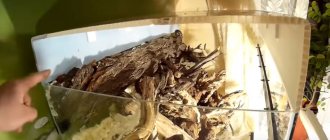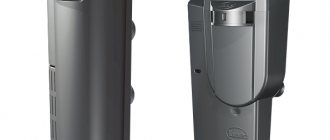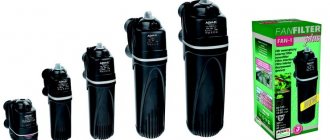How nice it is when you have an aquarium at home - a small piece of your own personal sea in the apartment! And behind its glass, colorful fish swim in crystal clear water. But, unfortunately, it will be impossible to see this beautiful picture without one small detail - the clean walls of the aquarium. During the life of fish and various plants, the glasses become overgrown with algae and mucus, which makes them cloudy, and there can no longer be any talk of beauty. This is not a problem if you have a small aquarium. But what to do if the amount of water in the fish house is hundreds of liters? To clean such glass, you will have to dive into the water, in the literal sense of the word.
In this case, magnetic aquarium scrapers will help solve the problem. They are very convenient to use. By moving the scraper along the outside of the glass, you automatically clean its inner surface.
Aquarium cleaning scraper: varieties
A scraper is a special tool that allows you to create cleanliness and order in your fish house without much effort. As a rule, in its simplest form it is a dense sponge attached with a metal frame to a straight handle.
In a specialized pet store you can choose such a scraper with a handle of different lengths depending on the size of the aquarium. There are scrapers with a rubber working surface and metal blades for removing thick layers of dirt.
There are also combined tools - scrapers with a sponge on one side and a blade on the other.
Magnetic scrapers have become widespread in recent years, the design of which will be discussed below. Ultra-modern battery-powered scrapers are also available for sale.
For example, the German company Eheim offers a cleaning device that automatically very effectively removes not only plaque, but even limescale formations. Not a bad gift for professional aquarists!
Magnetic scraper for aquarium
One of the popular types of scrapers. Consists of two magnets. On one magnet a soft material is glued, on the other a material with a hard pile. The principle is simple. A magnet with hard bristles is attached to the glass from the inside, and with a soft material from the outside. Magnets attract each other. Thus, by moving the external magnet, the internal one will also move, removing plaque from the glass. This type of aquarium scraper is good because you can clean the glass without getting your hands wet while sitting in front of the aquarium.
In some scrapers, the part that is immersed in the aquarium is made of lightweight materials, and if the attraction to the outer scraper is lost, it will not sink, but will float. But there are also significant disadvantages. With inexpensive magnetic scrapers, the quality of the hard bristles may not be very good and will result in poor cleaning. You will have to carry it along the wall of the aquarium several times. In addition, cheap scrapers may have weak magnets, and if the walls of the aquarium are made of thick glass, then the attractive force of the magnets will be insufficient.
Also, a big disadvantage of a magnetic scraper can be small pebbles or sand from the ground getting onto the cleaning surface. Thus, the cleaning surface will become something like sandpaper and will scratch the glass. You may not notice this right away, but over time, all the glass will be covered with micro-scratches, which greatly spoils the appearance of the aquarium. Another disadvantage I would consider is the poor quality of cleaning at the corners of the aquarium. I would recommend this scraper for tall aquariums, where it is difficult or impossible to reach all corners of the aquarium with other scrapers. The video below describes a scraper with a JBL Floaty Blade.
How to deep clean an aquarium with restart
Every aquarium needs a restart from time to time. It should not be carried out for prevention. Restarting an aquarium differs from the first start in that it is necessary to first sanitize the container and its contents.
Fish jigging
If the quality of the old aquarium water is sufficient, it is poured into a new container. The fish are transplanted there. Or use water that has been standing for at least two hours.
Important! You need to carefully monitor the behavior of the fish. Stress and changing conditions can cause illness or death.
Removing and washing plants and equipment
Living plants are washed with warm water and placed in a separate container. Filters and compressors are removed and thoroughly washed.
How to clean soil and decorations in an aquarium
To clean decorations in extreme conditions, it is acceptable to use bleach. Things must then be washed thoroughly. It is advisable to use boiling water. The soil is either replaced or processed. Processing consists of thoroughly washing the soil and calcining it in the oven.
Preparing and filling water
Water is prepared in the same way as during scheduled topping up. It is necessary to remember the concentration of various substances and compliance with PH, hardness and salinity.
Putting everything back in place
Starting the aquarium is carried out in the following order:
- Soil is laid out at the bottom.
- Suitable water is poured into the aquarium. The liquid level exceeds the ground level by about 10 cm.
- Plants and decor are placed.
- Equipment is being installed.
- Residents are starting.
- The water level is brought to the usual level in several steps.
- The equipment turns on.
The behavior of the fish must be carefully monitored at first.
How to remove algae from the walls of an aquarium:
Removing unwanted algae deposits from the walls of a home aquarium is actually quite simple, and this can be done using an ordinary trapezoidal blade from a stationery knife. You just need to make a special scraper (like a spatula) with a long handle.
This scraper is easy to make; you just need to thread the blade into a plastic tube. You can press the blade into an aluminum tube, in short, firmly fix it in the holder.
Using a blade scraper obtained in this way, you simply cut off (shave off) the green algae deposits from the walls of your aquarium.
The procedure is reminiscent of scraping chewing gum from the floor with a spatula, only much easier, more interesting, simpler and more enjoyable. You don’t need to put much pressure on the blade, and it won’t scratch the walls if you do everything carefully and methodically. The algae themselves will then either be eaten by the fish, or they will become fertilizer for other algae, or they can be collected the next time you clean the aquarium. I wish you harmony in the flora and fauna of your aquarium.
Aquarium scraper with blade
This tool is a good way to clean the walls of the aquarium if they are very overgrown with microorganisms. The working surface of the scraper resembles a safety razor.
The design of the device, where the blade is movable, allows you to clean out plaque even in the most inaccessible corners of the aquarium.
The plastic strip protects the glass from scratches, and the replaceable blade itself is made of stainless metal. Manufacturers offer a wide range of scrapers, as well as extension attachments for them.
Aquarium scraper with handle
These scrapers consist of a cleaning material (similar to the hard bristles in a magnetic scraper) and a handle. The handles and area of the cleaning material come in different sizes. The choice must be made depending on the size of the aquarium. Just as it will be inconvenient to clean a small aquarium with a large scraper, it will be laborious to clean a large aquarium with a small one. There are scrapers with a telescopic handle (extends to a certain length). Also, there are scrapers where instead of a cleaning material, the cleaning element is a blade.
The width of the blade should be chosen depending on the size of the aquarium. In addition, there are universal handle scrapers, with a changing cleaning element, material or blade. The advantages of such scrapers include the fact that you do not need to reach into the aquarium with your hands and you can clean the glass without getting your hands wet. The disadvantages are the same as with magnetic scrapers - a grain of sand can get in and scratch the glass. A more desirable option is a blade. Although under certain conditions it may leave a scratch on the glass.
How to properly clean an aquarium in a planned step-by-step manner
A routine cleaning of an aquarium involves several parts: cleaning the bottom, walls, decorations, filter (if necessary) and adding water. The aquarist’s movements should be smooth so as not to frighten the inhabitants.
Note! During scheduled cleaning, fish are not removed. This will cause more stress than cleaning. In addition, a sharp change in the composition of the water has a very bad effect on the health of fish.
The soil and bottom of the aquarium are cleaned last. As a result of previous actions, dirt and algae settle right there. Washing the soil removes debris and completes maintenance.
How to clean the walls of an aquarium
The walls are cleaned with special scrapers or a sponge without the use of cleaning agents. Particular attention must be paid to the corners. The type of tool depends on the material of the aquarium: glass is difficult to scratch, but for acrylic you will have to use the softest surface.
To begin with, the aquarist cleans the walls of the container from plaque. Next comes the turn of seams, corners and the ground area. If there is a lid, it is convenient to remove it and rinse the whole thing under running water.
It is usually enough to rinse the outer walls with warm water and wipe dry. A sponge will help with heavy dirt. Wipes for glass or monitors are safe and will eliminate streaks. You can use liquid to clean glass. If the aquarium does not have a lid, glass cleaners must be used carefully. The product is applied to half the walls, then distributed manually. Wipe the container with paper, newspaper without pictures, soft cloth, microfiber cloths.
Scenery
Stone and artificial plants are cleaned with running water and a sponge. For more severe stains, boiling water is used. Hydrogen peroxide and bleach are used only in extreme cases. Bleach must be diluted with water in a ratio of 1:9.
Important! After using cleaning products, rinse items thoroughly before placing them in the aquarium. Even a small amount of bleach will cause the death of all fish. Unwashed peroxide will disintegrate in water, but it will still not be beneficial for your pets.
Poor quality decorations can be damaged by bleach. Also, they cannot be used to process objects made of silk.
Only water is used to clean natural scenery. Some experts recommend not washing them at all. It’s really better not to even move snags and branches. The algae growing on them is often decorative and serves as food for some fish. Corals should not be moved either. But the stones need careful processing. If there is a lot of debris on the corals and branches, the problem is usually due to improper organization of the aquarium. Lack of space, too many fish, too much feeding - these are the things that need to be corrected first. If the tank becomes overgrown with algae too quickly, you need to fight the cause, not the effect.
Plant treatment
Many aquarium plants are easy to care for. They need to be cut and weeded. Trimming must be done regularly as algae grows quickly. Plants with long stems are most decorative from above, and timely pruning will preserve their appearance. Weeding is done carefully, without approaching the stem directly.
Some plants reproduce by layering. They will quickly fill the entire aquarium. If this scenario is undesirable, the cuttings should be removed at each scheduled cleaning.
Yellowed, fallen, rotting parts of algae must be removed. For these purposes it is convenient to use a narrow net.
Equipment
Timely cleaning of the filter is important for the well-being of the fish. The water pressure signals the need to do this. If it has become weaker, the device must be processed. It is clogged with food debris, algae and limescale.
The internal filter is the easiest to clean. You just need to rinse it under running water. Some people recommend using aquarium water for this so that the bacteria living on the filter do not die. However, these bacteria normally live in the soil. If the filter is washed with plain water, microorganisms will very quickly repopulate it. You will also need to clean the body of the device from algae and plaque.
You will have to clean the motor itself and its impeller somewhat less often. They are wiped with a clean dry cloth.
Be careful! Before disassembling the filter, disconnect it from the power supply.
Low-power filters in small aquariums must be treated with every scheduled cleaning. Stronger ones - every other time. Experts do not achieve perfect cleanliness when washing the filter. It will only harm the fish.
Some filter parts need to be replaced from time to time. There are disposable membranes that will have to be changed every week. Special sponges built into the device are replaced less frequently. If they are falling apart, it's time to buy new ones. The lifespan of the filter itself is also limited. At a certain point it stops being cleansed. You cannot treat it with detergents; you need to buy a new one.
The external filter is washed much less frequently. This is a more complex process. After disconnecting the device from the network, you must turn off the taps of the hoses, then separate the latter from the device. Next, the hoses, trays with filter filler, and the inside of the housing must be washed. This is convenient to do in the bath or shower. A narrow brush is suitable for hoses.
Afterwards the pallets must be placed back. Now comes the turn of the filter impeller. The housing is filled with water and the device is assembled. Hoses are connected. The aquarist then turns on the water supply and the electric current.
Important! When cleaning filters, do not use detergents! The smallest amount of cleaner will be distributed throughout the entire aquarium by the water flow. If the contamination is complex, hot water will help.
If the aquarium has a compressor, it also needs to be cleaned. Most often the hose becomes clogged. It can be cleaned or replaced. If the air filter is dirty, you will have to disassemble the device. You can wipe it from dust with a clean dry cloth.
The internal heating element is cleaned of algae. Usually you have to leave it on.
How to wash the soil in an aquarium
There is an opinion that aquarium soil must be cleaned by rinsing it with running water. Some beginners even heat it with boiling water. You can't do that. This will kill all beneficial microorganisms, disrupt the nitrogen balance in the aquarium and can lead to fish disease. Using a siphon is the correct way to clean.
Washing the soil too frequently should be avoided. This also has a negative effect on the fish. Cleaning once every two times will be sufficient.
How to clean the bottom of an aquarium
If there is no soil in the aquarium, the bottom is cleaned with a scraper. After which the waste layer is removed with a siphon.
Cleaning and adding water to the aquarium
Water change volumes are from 10% to 50% at a time. The frequency of water changes also varies. The water cannot be completely drained. Tap water won't work either. It contains too much chlorine. To purify water, it must be left for a day. Or you need to use special products such as air conditioners. Vitamins and mineral supplements will tailor the water exactly to the desired fish. Aquarium salt is used to obtain sea water.
Attention! If the water is cloudy, changing it completely can only make it worse.
If the liquid has deteriorated after adding fish or changing the water, it is usually enough to wait a few days. The sediment will settle to the bottom. If fresh water has not been added, the following options are possible:
- The filter has deteriorated or become dirty. It needs to be replaced or cleaned.
- Burrowing fish can lift a lot of soil from the bottom. They need a more powerful filter.
- The aquarium is overcrowded. You will have to put some of the fish in another container.
- Insufficient quality or too infrequent cleaning of the aquarium.
- Driftwood and branches release tannins when placed in water. They color the liquid and are liked by many fish. After some time, the tank will be clean again.
- Poor quality decorations are used. Poor quality varnish or paint can leach into the water, changing its color and poisoning the inhabitants. Such items must be removed immediately.
DIY aquarium scraper
A scraper can also be obtained from improvised means. For example, a dishwashing sponge. It consists of a soft sponge and a hard material on the other. Use the hard side of the sponge to clean the glass. She scrubs well. But as in other cases with hard material, it can scratch glass. I checked this from my own experience. I cleaned the aquarium with such a sponge for a long time and everything was fine, but when I put on a brighter light over time, I saw that all the glass was covered with micro-scratches.
Another cheap and cheerful way to clean glass is with an ordinary blade. It perfectly removes even the toughest, long-formed plaque. Of the minuses, there is a high probability of cutting yourself, as well as cutting the seam on the aquarium and getting a leak. Well, if handled carelessly, you can scratch the glass.
And finally, the best scraper for an aquarium , which is time-tested and which I myself have been using for a long time, is a plastic card . An unwanted hard plastic loyalty card or expired credit card makes a great scraper. It's practically a free scraper. The plastic is hard enough to clean glass. It doesn't clean much worse than a blade, but you definitely won't scratch the glass with this scraper, even if you have an acrylic glass aquarium. There are some disadvantages, but they are minor. As in the case of the blade, you need to wet your hands (in a large aquarium up to your shoulder:) If the aquarium is too high, then you may not be able to reach the bottom. Otherwise, I highly recommend this type of glass cleaning.
Purpose of the accessory
Cleanliness of aquarium glass is not only an aesthetic beauty, but also an important point in maintaining hygiene.
- It is worth buying a scraper for cleaning an aquarium to combat limescale deposits that darken the glass and obscure the view. And algae, which often grow on the walls and require periodic removal.
- Over time, mucus forms on the walls, microorganisms accumulate, which negatively affect the quality of water, the condition of aquarium plants and residents.
Magnetic scraper for an aquarium: pros and cons
This cleaning tool is very convenient to use and quite effective. The design and principle of application are already included in the very name of the tool.
It is a combination of two flat magnets with a strong magnetic field. The attraction of the two parts of such a device ensures fairly effective cleaning of vertical surfaces both inside and outside the aquarium.
Tools are available for glass of various thicknesses. The thicker the aquarium glass, the stronger the magnetic field.
The indisputable advantage of magnetic scrapers is
- the ability to clean without putting your hands or any objects into the water,
- the process does not irritate or frighten the inhabitants of the aquarium.
As a disadvantage, we can mention its low efficiency when cleaning a thick layer of microorganisms or when removing limescale.
For ease of use and storage, many manufacturers of aquarium accessories make the inside of the tool floating. When not working, the scraper rests freely on the surface of the water.
WHAT IS AN AQUARIUM FLUIDIZED BED FILTER?
ALL ABOUT WOOD IN AQUARIUM
AERATION OF WATER IN AQUARIUM - METHODS USED BY THE PEOPLE
Washing in an emergency in case of contamination and contamination of water
Restarting the aquarium is an emergency measure; it consists of a complete change of water, thorough cleaning of surfaces and complete or partial replacement of plants. This procedure is necessary if the aquarium is infected or the water in it is severely polluted. In the photo below you can see what heavy pollution looks like.
Inaction in such a situation will lead to diseases and death of fish, so as soon as possible it is necessary to temporarily relocate the inhabitants from the contaminated reservoir and carry out general cleaning.
The contaminated container is emptied completely and filled with disinfectants for a day. Bleach and potassium permanganate solution are best suited for these purposes.
All equipment removed from the aquarium is subjected to heat treatment (boiling), and after disinfection, the aquarium itself is thoroughly rinsed and left to dry for at least 24 hours.
The launch of the reservoir is carried out in several stages. After drying, add water, about a third of the maximum volume. Purified soil and artificial elements are placed inside. The container is left in this form for 5–7 days, and then the preserved algae are planted.
After another 3-5 days, add water and put the fish inside.








